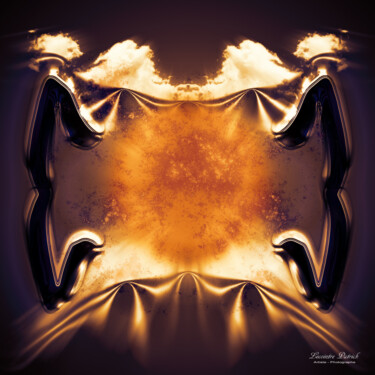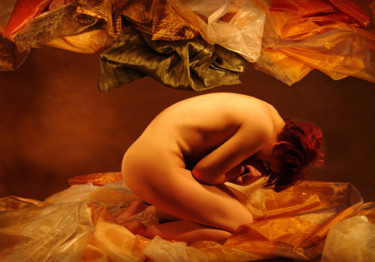The Nativity
Christmas, the day celebrating the birth of Jesus Christ, has been immortalized by many famous works of art depicting the Nativity, among which, the oldest is most likely the stucco preserved in the catacombs of Priscilla, in Rome, dating back to the third century. This early Christian work is distinguished by being particular and non-canonical, since it depicts Mary and Jesus, in the company of a prophet, pointing to a star, a symbol of the coming of Christ on earth. In fact, this mode of representation is clearly detached from the traditional one, which, about two centuries later, has immortalized the Virgin and child, in the company of the angel, the shepherds and Joseph. Representative examples of what has been said are the Nativity between the prophets Isaiah and Ezekiel by Duccio di Buoninsegna, the Nativity of Jesus by Giotto and The Adoration of the Shepherds by Rubens. Later, however, the various artists who faced this subject, enriched the above composition with further details and personal reinterpretations, as demonstrated by the Mystical Nativity by Botticelli, the Adoration of the Child by Perugino, the Nativity and Adoration of the Shepherds by Ghirlandaio, the Nativity by El Greco and the Nativity with Saints Lawrence and Francis of Assisi by Caravaggio.
 Nativity, 3rd century. Stucco, Rome: catacombs of Priscilla.
Nativity, 3rd century. Stucco, Rome: catacombs of Priscilla.
 Duccio di Buoninsegna, Nativity between the prophets Isaiah and Ezekiel, 1308-13011. Tempera on panel, 43.8 × 111 cm. Washington: National Gallery of Art.
Duccio di Buoninsegna, Nativity between the prophets Isaiah and Ezekiel, 1308-13011. Tempera on panel, 43.8 × 111 cm. Washington: National Gallery of Art.
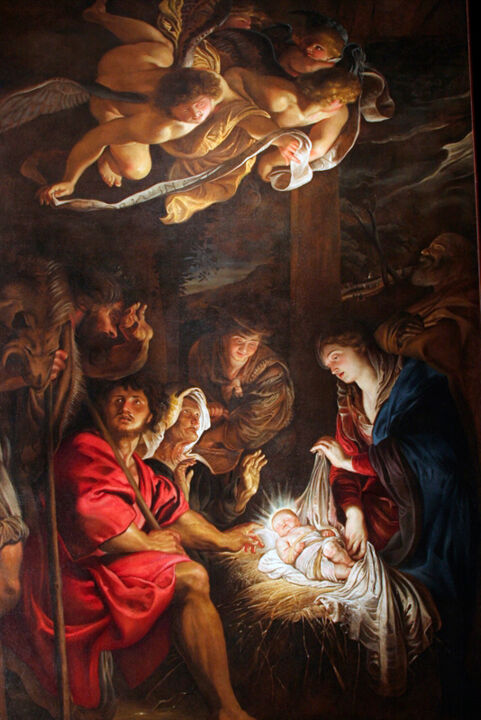 Pieter Paul Rubens, The Adoration of the Shepherds, 1608. Oil on canvas, 300×192 cm. Fermo: Pinacoteca Civica.
Pieter Paul Rubens, The Adoration of the Shepherds, 1608. Oil on canvas, 300×192 cm. Fermo: Pinacoteca Civica.
 Sandro Botticelli, Mystical Nativity, 1501. Tempera on canvas, 108.5 × 75 cm. London: National Gallery.
Sandro Botticelli, Mystical Nativity, 1501. Tempera on canvas, 108.5 × 75 cm. London: National Gallery.
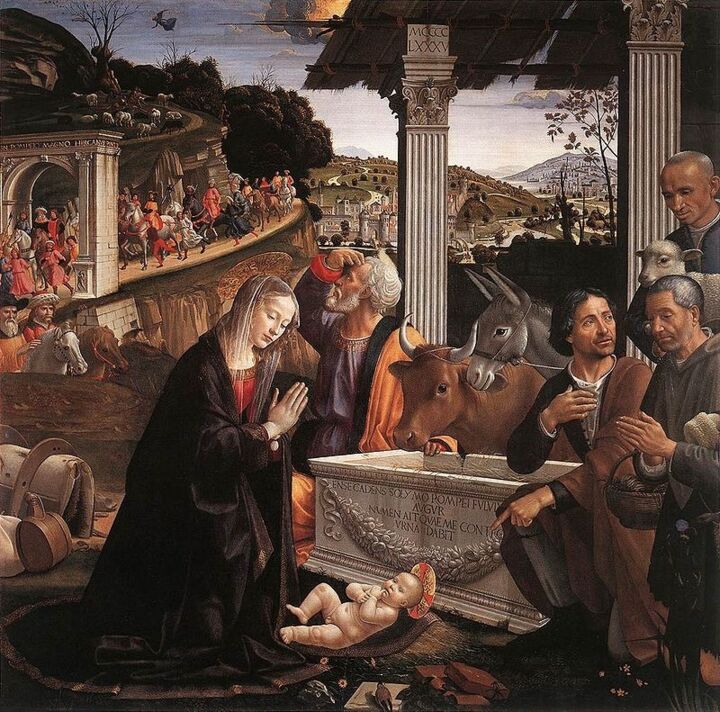 Domenico Ghirlandaio, Nativity and Adoration of the Shepherds, 1485. Tempera on panel, 167 x 167. Florence: Basilica of Santa Trinita.
Domenico Ghirlandaio, Nativity and Adoration of the Shepherds, 1485. Tempera on panel, 167 x 167. Florence: Basilica of Santa Trinita.
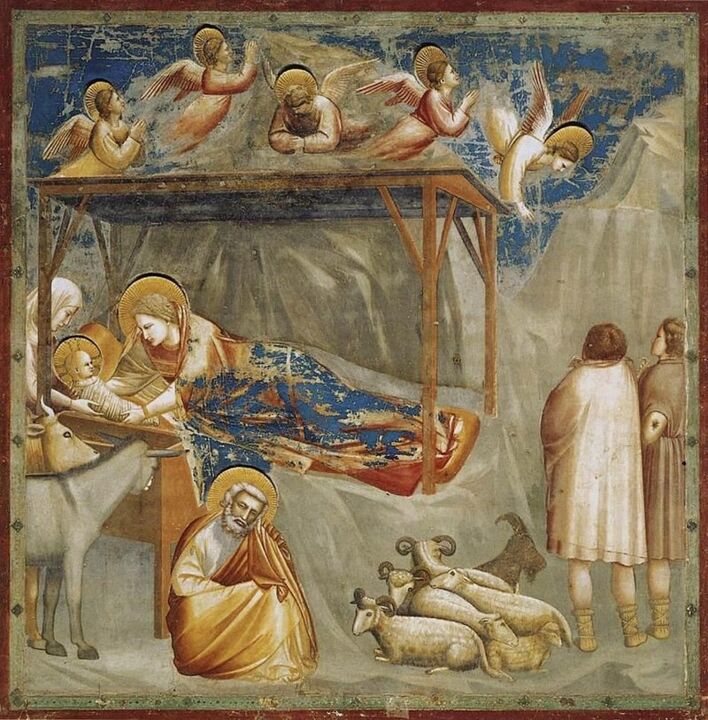 Giotto di Bodone, Nativity of Jesus, 1303-1305. Fresco, 200 x 185 cm. Padua: Scrovegni Chapel.
Giotto di Bodone, Nativity of Jesus, 1303-1305. Fresco, 200 x 185 cm. Padua: Scrovegni Chapel.
Giotto: the Nativity of Jesus
Among the most popular Nativities in the history of art there is certainly that of Giotto, part of the cycle of frescoes that, included in the Stories of Jesus, decorate the Scrovegni Chapel, in Padua (Italy). In fact, this work, which has become the point of reference for the artists of the following generations, has managed to renew one of the most traditional iconographies of Christian art, through an unprecedented simplicity and humanity. As far as humanity is concerned, it emerges both from the face of Mary, lovingly taken to look at her son, and from the attitude of adoration that the animals direct at the newborn. These feelings are joined by the amazement of the shepherds, the joy of the angels and the meditative serenity of Joseph. All these figures are characterized by a refined, measured beauty and regular features, which refer to the classical world. Giotto's masterpiece, however, is not only innovative for the recovery of ancient art and the desire to humanize the sacred event, but also for its spatial research, perspective and plasticism of its characters. As far as the description of the work is concerned, such Nativity is set in a rocky place, where the hut in which Mary, Jesus and a woman, a new character included in the story, who lends herself to help the Virgin with her newborn son, emerges strongly. Regarding the other characters, Joseph is painted far from his family, that is, in the lower part of the fresco, in order to highlight his subordination to the Divine Father of Christ. The ox and the donkey, however, are on the left side of the work, while, on the right, are depicted the two shepherds, intent on dialoguing with an angel, who informs them of the happy event. Finally, we find, floating above the hut, four angels intent on praying.
Marc Chagall, The Birth, 19011. Oil on canvas, 46×36 cm. Private collection.
Marc Chagall: The Birth
The topic of the Nativity has also been investigated in its secular version, as seen, for example, in Marc Chagall's work, The Birth, and Salvador Dali's, Geopolitical Child Looks at the Birth of the New Man. Regarding Chagall's painting, this canvas, highly narrative and rich in details, represents an explicit manifesto of the artist's poetics, often marked by the use of details of everyday life, which, translated into symbolic images, are disclosed in all their specificity. In fact, the canopy, specially painted in red by the artist, symbolizes the maternal womb, which is the feminine principle and symbol of life. As for the characters depicted, the left side of the work is built on a pyramidal composition, which sees as protagonists the figure of the mother, the midwife, who holds the newborn in her arms, and a man, comically sitting on the floor while watching the scene. On the right side of the work, however, are portrayed an old man and a child intent on peeking through the window and some men who, within a luminous circle traced on the floor, are intent on discussing. Finally, among the latter characters stands out the figure of a cow, which, innovatively, enters the space of the image on equal terms with human beings.
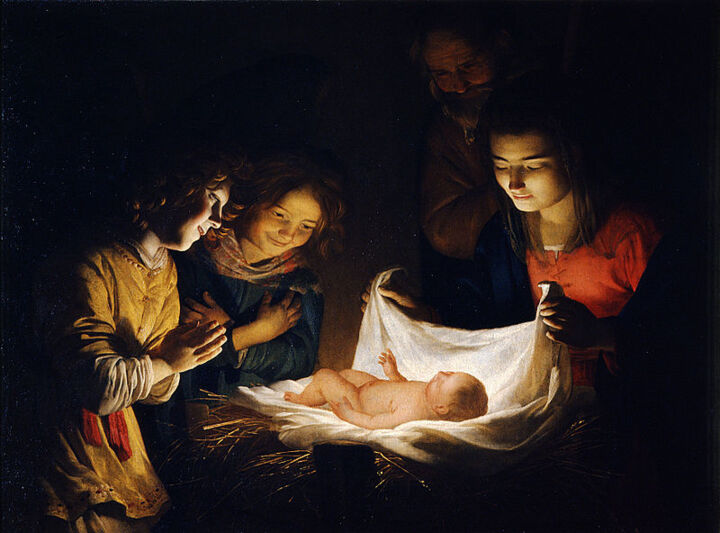 Gerrit Van Honthorst, The Adoration of the Child, 1619-1620. Oil on canvas, 95.5 × 131 cm..
Gerrit Van Honthorst, The Adoration of the Child, 1619-1620. Oil on canvas, 95.5 × 131 cm..
 Catherine Digue - Turpin, Nativite3, date unknown. Gouache, 22 x 30 cm.
Catherine Digue - Turpin, Nativite3, date unknown. Gouache, 22 x 30 cm.
Catherine Digue - Turpin: Nativite3
The artists of Artmajeur have also tried their hand at depicting Nativity, both sacred and profane, such as, for example, the very traditional gouache by Catherine Digue - Turpin, which is similar to the classic and religious interpretation of the same topic executed by Gerrit Van Honthorst, preserved at the Uffizi Gallery in Florence. In fact, like the Florentine masterpiece, the work of Digue - Turpin, although less realistic and detailed, has its focus in the figure of the child, who is contemplated by the other characters above him. Moreover, in both paintings, the arrangement and mode of execution of the light generates a "muffled" atmosphere, harmonious and calm, which is perfectly capable of conveying the magic of Christmas. Therefore, the gouache of Digue - Turpin falls perfectly within the figurative tradition of the sacred event, so much so that, in addition to the work of Gerrit Van Honthorst, it could also be compared to Correggio's Adoration of the Shepherds and Carlo Maratta's Nativity.
 Paul Rossi, The family of Harlequin IV, date unknown. Oil on paper, 57 x 76.5 cm.
Paul Rossi, The family of Harlequin IV, date unknown. Oil on paper, 57 x 76.5 cm.
Paul Rossi: The family of Harlequin IV
The work of the artist from Armajeur, Paul Rossi, represents, as stated by himself, a profane and ironic Nativity, in which the members of Harlequin's family are depicted, a character that immediately reminds us of the painting, of the same subject, executed by Pablo Picasso. In fact, the Spanish artist's Family of Harlequin with Monkey also immortalizes, albeit with a smaller number of protagonists than Rossi's work, a sweet scene of family life, enlivened by the presence of a new arrival. In addition, the figure of the monkey also unites the two paintings, despite the fact that, in Picasso's work, the latter has a more emotionally active role within the family picture. The two paintings, despite these common elements, are the result of two very personal and different styles of realization, which differ mainly in the mode of execution of chiaroscuro and, consequently, in the rendering of the characters' features. In this regard, the protagonists of the work of the artist of Artmajeur, made with a chiaroscuro more intense and less nuanced, have harder and angular features, compared to those made by Picasso. Moreover, the black and white of Rossi's artwork is very far from the soft colors used by the Spanish artist, who made this famous painting during his pink period. In conclusion, Rossi wanted to make a classic topical of art history in a fun and very personal way, referring, most likely, to the work of the great Spanish master.
 Raphael Sanzio, Madonna of the Goldfinch, 1506. Oil on panel, 113 x 88 cm. Vienna: Kunsthistorisches Museum.
Raphael Sanzio, Madonna of the Goldfinch, 1506. Oil on panel, 113 x 88 cm. Vienna: Kunsthistorisches Museum.
 Frédéric Martin, F-Martin-Nativite, date unknown. Oil on canvas, 55 x 33 cm.
Frédéric Martin, F-Martin-Nativite, date unknown. Oil on canvas, 55 x 33 cm.
Frédéric Martin: F-Martin-Nativite
Frédéric Martin's realistic and innovative Nativity simply depicts a baby in swaddling clothes, who, deprived of the context of the hut, the presence of the Virgin, Joseph, angels and shepherds, we can believe to be Christ only by the title attributed to the canvas. In the history of art, the most accurate study of the character of the infant Jesus has taken place in the works depicting the Virgin and Child, which were made by the most important masters of all time, including Duccio di Buoninsegna, Beato Angelico, Filippo Lippi and Raphael. In these masterpieces, however, unlike Martin's canvas, the Child was depicted nude or semi-clothed, as, for example, in Raphael's Madonna of the Goldfinch, where Jesus is immortalized in all his roundness and softness. Therefore, in the work of the artist of Artmajeur, to innovative way of representing the theme of the Nativity is added to the very personal choice of concealing the body of Christ with bands.


 Olimpia Gaia Martinelli
Olimpia Gaia Martinelli




